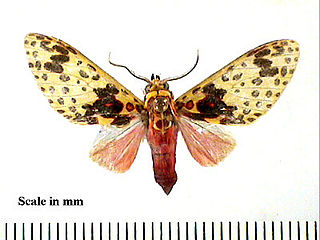
Nola is a genus of moths described by William Elford Leach in 1815. They are the namesake of the subfamily Nolinae and the family Nolidae. This genus occurs worldwide wherever suitable habitat is present.

Amaxia is a genus of moths in the family Erebidae erected by Francis Walker in 1855. The type species of the genus is Amaxia pardalisWalker, 1855.

Cisthene is a genus of lichen moths in the family Erebidae. The genus was erected by Francis Walker in 1854.

Eucereon is a genus of tiger moths in the family Erebidae. The genus was erected by Jacob Hübner in 1819.

Leucanopsis is a genus of moths in the family Erebidae. The genus was described by Alfredo Rei do Régo Barros in 1956.
Paracles is a genus of moths in the subfamily Arctiinae. The genus was described by Francis Walker in 1855. The species range from Panama to Patagonia, with quite a few in the southern temperate region of South America.
Erupa is a genus of moths of the family Crambidae.

Lamprosema is a genus of moths of the family Crambidae described by Jacob Hübner in 1823.

Syllepte is a genus of moths in the family Crambidae.
The 32nd South American Junior Championships in Athletics were held in São Leopoldo, Brazil at the University of Unisinos Track club from October 7–8, 2000. Athletes from Portugal were invited to participate as guests.

Amaxia bella is a moth of the family Erebidae. It was described by William Schaus in 1905. It is found in French Guiana and Suriname.
Amaxia carinosa is a moth of the family Erebidae. It was described by William Schaus in 1920. It is found in Guatemala.

Amaxia consistens is a moth of the family Erebidae. It was described by William Schaus in 1905. It is found in Brazil.
Amaxia corata is a moth of the family Erebidae. It was described by William Schaus in 1921. It is found in Brazil.
Amaxia hebe is a moth of the family Erebidae. It was described by William Schaus in 1892. It is found in Brazil.
Amaxia laurentia is a moth of the family Erebidae. It was described by William Schaus in 1905. It is found in French Guiana.
Amaxia lepida is a moth of the family Erebidae. It was described by William Schaus in 1912. It is found in Costa Rica.
Amaxia pyga is a moth of the family Erebidae. It was described by William Schaus in 1892. It is found in Brazil.
Amaxia tierna is a moth of the family Erebidae. It was described by William Schaus in 1920. It is found in Guatemala.






